
Beer Terminology: Do you know your Malts from your Hops?
Share

Confused by the increased numbers of beers on the market and even more confused by the types of beer and terminology branded round the market. So, what do they mean, we’ve laid out a shortlist of beer types and elements of the beer-making processes to help:
WORTS
Not to be mistaken for a skin growth issue. A wort is how all beer begins. Wort is the liquid resulting from mashing of the malted barley at the beginning of the beer process. For beer making, hops and yeast are then added to the wort before fermentation commences. The yeast then transforms the sugar in the wort into alcohol and produces CO2 that makes the beer sparkling in appearance.
HOPS
Similar to a grapevine, hops are a climbing plant. In the beer-making process, the female ripened hop flower is used to add aroma and flavour. Popular in IPA (India Pale Ale) production. Hops are added at various stages of the process:
Start - Bittering hops are added
Middle - Flavouring hops are added
Boiling/Brewing Process – Dry hops added
End – Aroma hops are added
MALT
Malt is essentially a grain of barley that has been germinated to free enzymes that help to transform the starch from the maltose (sugar). The colour of beer will very much depend on how long the grain has been heated up for:
Pale colour – heated up to a high temperature for a short period
Copper colour – heated for longer at lower temperatures
The darker the malt the more burnt or caramelised flavours will be present in the beer.
BARLEY
The main cereal used in the beer production process. Malted barley is a common grain that starch is extracted from during the brewing process to extract the sugars necessary to be turned into alcohol. Wheat is also used to promote a foamy and more persistent head to the beer.
LAGER
By far the most commonly consumed type of beer. Unlike Ale, lager is usually brewed at cooler temperatures. Fermentation of lager takes longer producing more alcohol, gas and a cleaner more neutral taste and flavour.
ALE
Widely known as a malt style drink. Commonly brewed with barley malt and fermented at high temperatures. It can be difficult to produce this style consistently. Production of ale introduces beers with more body, complexity and different flavours. They come in a variety of colours and strengths.
We hope this sheds a little light into the world of beer terminology. There are plenty of beer selections to choose from within the www.order.beer website, perhaps you could do your own tasting session?
